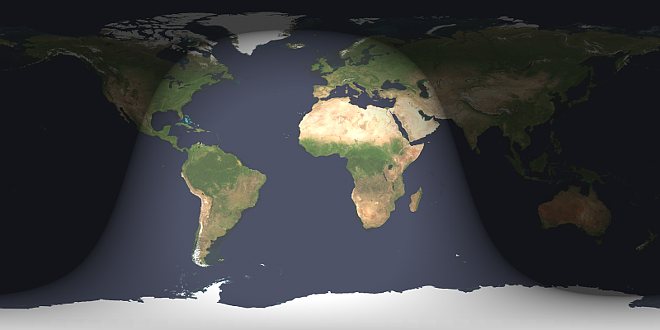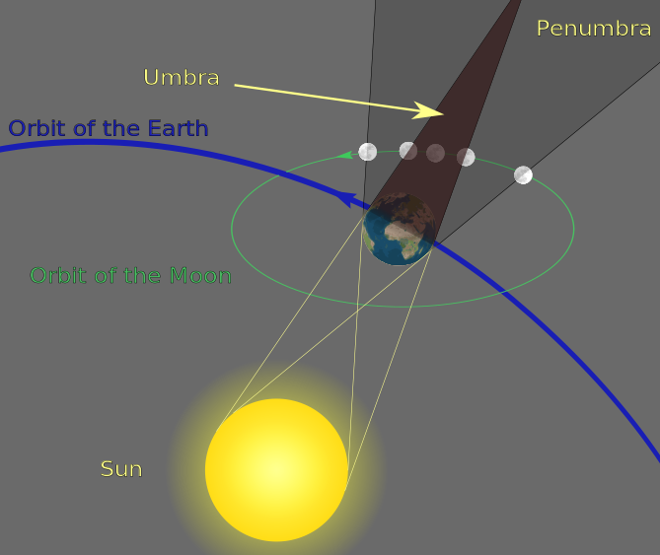|
Super Blue Moon total lunar eclipse coming
January 31 |
|
January 21, 2018 |
 |
| Worldwide
map via the US Naval Observatory showing
the day and night sides of Earth at the
instant of the greatest eclipseJanuary
31 at 6:30 a.m. Pacific Time. Greatest
eclipse happens at the same instant
worldwide; you must be on the night side
of the world to witness it. The shadow
line at the left depicts sunrise
(moonset) January 31, and the shadow
line at right represents sunset
(moonrise) January 31. Since the total
eclipse lasts more than one hour, if you
live somewhat east (right) of the
sunrise line, you can still catch a
total or partial eclipse low in the west
before sunrise (and before greatest
eclipse). Or if you live somewhat west
(left) of the sunset line, you can still
catch a total eclipse low in the east
after sunset (and after greatest
eclipse). |
|
By Bruce McClure
The Blue Moon – second of two full moons in one
calendar month – will pass through the Earth’s
shadow on January 31 to give us a total lunar
eclipse. Totality, when the moon will be
entirely inside the Earth’s dark umbral shadow,
will last a bit more than one-and-a-quarter
hours. The January 31 full moon is also the
third in a series of three straight full moon
supermoons – that is, super-close full moons.
It’s the first of two Blue Moons in 2018. So
it’s not just a lunar eclipse, or a Blue Moon,
or a supermoon. It’s all three … a super Blue
Moon eclipse!
If you live in North America or the Hawaiian
Islands, this lunar eclipse will be visible in
your sky before sunrise on January 31. On
the other hand, if you live in the Middle East,
Asia, Indonesia, Australia or New Zealand, this
lunar eclipse will happen in the evening hours
after sunset on January 31.
In the Pacific Standard Time Zone, the partial
umbral eclipse begins at 3:48 a.m., total
eclipse begins at 4:52 a.m., greatest eclipse
will be at 5:30 a.m., total eclipse ends at 6:08
a.m., and partial umbral eclipse ends at 7:11
a.m., though the moon may set before end of
partial umbral eclipse.
Is it the first Blue Moon total eclipse in 150
years, as some claim? Well … It depends on where
you live. Yes, we’ve seen the social media memes
going around suggesting this is the first Blue
Moon total eclipse in 150 years.
But the meme is true only for time zones in and
around the Americas, not for the rest of the
world. The last time that we had a Blue Moon
total lunar eclipse – reckoning in world time –
was December 30, 1982.
That wasn’t a Blue Moon eclipse for the
Americas, however. For us, the full moon
previous to the total lunar eclipse fell on
November 30 – not December 1.
Before that, there was a Blue Moon total lunar
eclipse for the world’s Eastern Hemisphere
(Asia, Indonesia, Australia and New Zealand) on
December 30, 1963.
Okay, now, finally we get to it. Before that, in
late March 1866, there was a Blue Moon total
lunar eclipse for North and South American time
zones.
By the way, the next Blue Moon total lunar
eclipse will happen on December 31, 2028.
Story continues below image
 |
| In any
umbral lunar eclipse, the moon always
passes through Earth’s very light
penumbral shadow before and after its
journey through the dark umbral shadow. |
A partial lunar eclipse precedes the total
eclipse by a little over one hour, and follows
totality for a little over one hour.
So, from start to finish, the moon takes three
hours and 23 minutes to totally cross Earth’s
dark umbral shadow. Eastern North America can
see beginning stages of the partial umbral
eclipse low in the west before sunrise January
31, whereas portions of the Middle East and
far-eastern Europe can view the ending stages of
the partial umbral eclipse low in the east after
sunset January 31.
South America, most of Europe and Africa won’t
be able see this eclipse.
Incidentally, a very light penumbral eclipse
comes before and after the dark (umbral) stage
of the lunar eclipse. But this sort of eclipse
is so faint that many people won’t even notice
it. The penumbral eclipse would be more fun to
watch from the moon, where it would be seen as a
partial eclipse of the sun.
A lunar eclipse can only happen at full moon.
Only then is it possible for the moon to be
directly opposite the sun in our sky, and to
pass into the Earth’s dark umbral shadow.
Most of the time, however, the full moon eludes
the Earth’s shadow by swinging to the north of
it, or south of it. For instance, the last full
moon on January 2, 2018, swung south of the
Earth’s shadow. The next full moon – on March 2,
2018 – will swing north of the Earth’s shadow.
The moon’s orbital plane around Earth is
actually inclined at five degrees to the
ecliptic – Earth’s orbital plane around the sun.
However, the moon’s orbit intersects the
ecliptic at two points called nodes. It’s an
ascending node where it crosses the Earth’s
orbital plane going from south to north, and a
descending node where it crosses the Earth’s
orbital plane, going from north to south.
In short, a lunar eclipse happens when the full
moon closely coincides with one of its nodes,
and a solar eclipse happens when a new moon does
likewise. It’s not a perfect alignment this time
around, with the moon turning full about five
hours before the moon crosses its ascending
node. But that’s close enough for this full moon
to stage a total lunar eclipse that lasts a
touch more than one and a quarter hours. |
|
Questions or comments about this
letter?
Click here to e-mail! |
|
|
|
|

